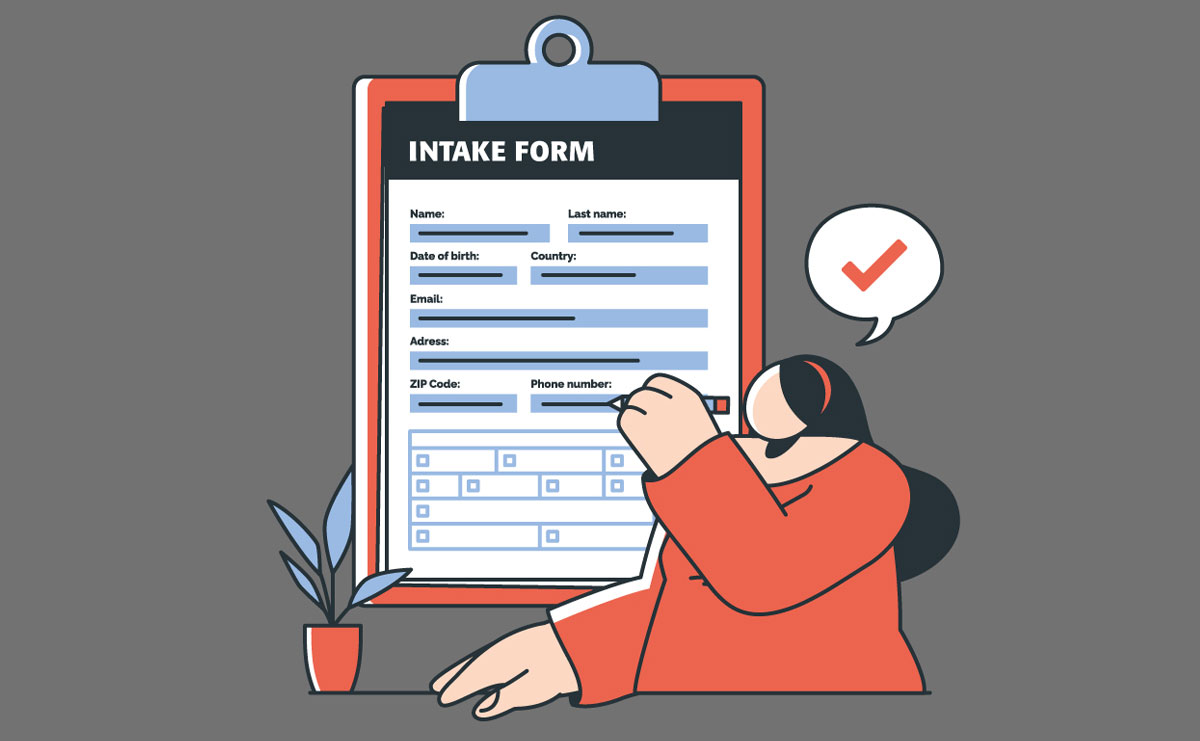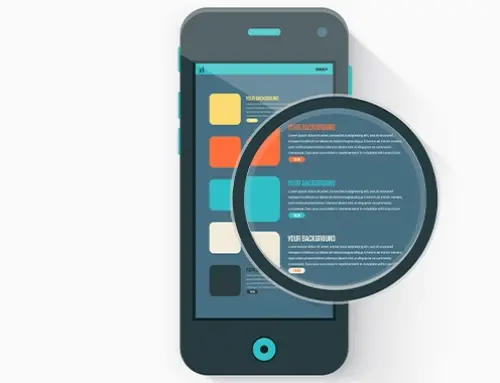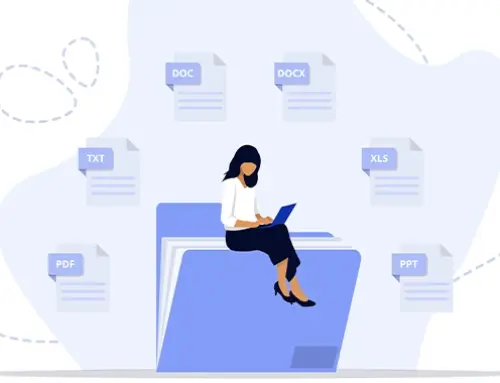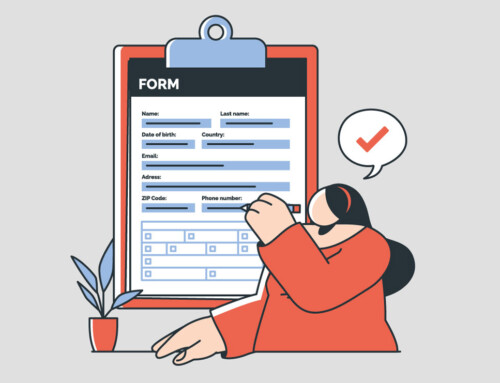Contents
The Ultimate Guide to Perfecting Your Law Firm Client Intake
Having an efficient and seamless client intake process in a law firm is a beneficial method to hold the clients over time. A well-structured law firm client intake maintains contact with clients in terms of responding to them more quickly. The client intake process also can help the firm with analyzing the satisfaction level of clients with the services they deliver.
Steps to Building a Successful Client Intake Process
A successful client intake process ensures law firms can manage client relationships efficiently while addressing potential issues early. By following a structured approach, law firms can streamline workflows, reduce administrative burdens, and create a positive first impression. This section outlines the critical steps in developing an effective law firm client intake system.
I. Welcoming Potential Clients
The client intake journey begins with making potential clients feel valued and respected. First impressions are crucial, as this stage sets the tone for the client’s entire experience with the law firm. Clear communication, prompt responses to inquiries, and a friendly yet professional demeanor help build trust from the outset. Whether through phone, email, or online contact forms, the initial interaction must reflect the firm’s commitment to effectively address the client’s legal needs effectively.
II. Gathering Initial Contact Information
The next step involves collecting basic information from the prospective client. This includes personal details like name, contact information, and the nature of their legal issue. Creating a standardized form for gathering these details is essential to ensure consistency. Many firms utilize an intake service for law firms to digitize and automate this process, making it quicker and reducing the risk of errors.

III. Pre-Screening for Suitability
Pre-screening is a vital part of the law firm’s client intake process. During this stage, the firm evaluates whether the client’s legal issue aligns with its expertise. This may involve assessing the complexity of the case, the jurisdiction, and any immediate deadlines. Pre-screening saves the firm time and ensures clients are matched with the proper legal representation.
IV. Conducting Conflict Checks
Before proceeding further, the firm must conduct a conflict-of-interest check. This ensures the firm can represent the potential client without compromising its ethical obligations. Many firms incorporate conflict-checking protocols into their client intake process, leveraging case management software or dedicated tools to streamline the procedure.
By carefully implementing these steps, law firms can create an efficient and client-centric intake system. Each stage is designed to minimize delays, improve communication, and establish a solid foundation for the attorney-client relationship.
Tools and Technology for Streamlining Intake
Technology plays a pivotal role in optimizing the law firm client intake process. Using modern tools and software such as RunSensible, law firms can handle administrative tasks efficiently, reduce errors, and enhance client experience. This section explores the key technologies and tools that can transform a client intake process into a seamless operation.
I. The Role of Legal Intake Software
Legal intake software is at the heart of a modernized client intake process. These tools allow law firms to collect, organize, and store client information securely and systematically. Intake software often includes features like automated data entry, digital forms, and integration with practice management systems, ensuring no critical detail is overlooked. In addition, such software reduces the need for manual paperwork, freeing up valuable time for attorneys to focus on providing legal expertise.
II. Benefits of Automation in Client Intake
Automation significantly enhances the efficiency of the law firm client intake process. Automated workflows can handle repetitive tasks like sending confirmation emails, scheduling consultations, and triggering follow-up reminders. For instance, an intake service for law firms often leverages automation to streamline client communications and ensure timely responses. By reducing reliance on manual processes, firms can provide faster and more consistent experience for prospective clients.
III. Integration with Practice Management Systems
Integrating intake tools with broader practice management systems offers a cohesive approach to client management. When intake software connects directly with a law firm’s case management platform, information flows seamlessly from one stage to the next. This eliminates the need for duplicate data entry and minimizes the risk of errors during transitions. For firms that utilize an intake service for law firms, integration ensures that every step of the process is connected, from initial contact to case resolution.
By adopting these tools and technologies, law firms can modernize their client intake process, ensuring it is both efficient and client friendly. The strategic use of software and automation enhances productivity, reduces costs, and helps create professional and streamlined experience for every client.
Common Client Intake Mistakes to Avoid
A successful law firm client intake process requires careful planning and attention to detail. However, many firms encounter common pitfalls that hinder efficiency and leave clients dissatisfied. This section examines the most frequent mistakes in the client intake process and provides insights into avoiding them.
I. Relying on Manual Processes
One of the most significant mistakes law firms make is relying on outdated, manual methods for client intake. Paper-based systems or inconsistent digital workflows are prone to errors, delays, and lost information. Modernizing the client intake process with tools like legal intake software or an intake service for law firms can help eliminate these inefficiencies. Automation and centralized databases ensure client information is captured accurately and securely, reducing the risk of overlooked critical details.
II. Inconsistent Procedures Across Staff
When intake procedures vary between staff members, it leads to confusion, miscommunication, and errors. Lack of standardization in the law firm client intake process can also create an uneven client experience, potentially damaging the firm’s reputation. Establishing clear guidelines and utilizing tools to enforce consistency ensures that every potential client receives the same level of professionalism and care, regardless of who handles their intake.
III. Delayed Follow-Ups with Clients
Timely communication is essential in creating a positive first impression. Delays in responding to potential clients can lead to lost opportunities, as prospective clients may turn to competing law firms. A robust intake service for law firms can address this challenge by automating follow-up communications and scheduling. Quick and consistent follow-ups demonstrate the firm’s commitment and reliability, increasing the likelihood of converting inquiries into retained clients.
Avoiding these common mistakes is critical to building a streamlined, client-focused intake process. Law firms can enhance their client intake process by adopting modern tools like RunSensible, creating standardized workflows, prioritizing prompt communication, and improving their overall operational efficiency.
Best Practices for Enhancing Client Experience
An effective law firm client intake process ensures operational efficiency and creates a positive experience for clients. Focusing on the client’s needs and expectations during intake builds trust and sets the foundation for a strong attorney-client relationship. This section highlights best practices for improving the client intake process while prioritizing client satisfaction.
I. Allowing Clients to Self-Schedule Consultations
One of the simplest ways to enhance the client intake process is to offer clients the ability to schedule their consultations online. Many modern intake tools and platforms support self-scheduling features, allowing clients to select appointment times that are convenient for them. This eliminates back-and-forth communication, saves time, and provides a sense of control for the client. Firms utilizing an intake service for law firms can integrate self-scheduling tools to make this process seamless and accessible.
II. Discussing Fees Transparently and Early
Transparency in discussing legal fees is critical to building trust with clients. During intake, clients should be provided with clear information about the firm’s fee structure, including any retainer requirements or payment plans. Addressing financial expectations upfront reduces misunderstandings and helps clients make informed decisions about proceeding with the firm. A streamlined law firm client intake system should include mechanisms to efficiently share fee agreements and obtain client acknowledgment.
III. Creating Clear Communication Channels
Clients value prompt and effective communication, especially during the initial stages of engagement. Establishing clear communication channels, ether through website or email, as part of the client intake process helps ensure that clients feel heard and supported. This can include setting expectations about response times, assigning a dedicated point of contact, and using technology to track and manage communications. Firms that use an intake service for law firms often find these services invaluable for maintaining consistent and professional communication with potential clients.
By implementing these best practices, law firms can transform their client intake process into a client-centric experience. From providing self-service options to fostering transparency and responsiveness, these steps ensure that clients feel valued and confident in their choice of legal representation.
Improving Efficiency with Intake Services for Law Firms
For many law firms, managing the client intake process can be a resource-intensive task that distracts from core legal work. This is where specialized intake services can make a significant difference. By outsourcing or utilizing dedicated services, law firms can streamline their operations, improve client interactions, and focus on delivering legal expertise. This section explores the role of intake services and how they contribute to an efficient law firm client intake system.
I. What Are Legal Intake Services?
An intake service for law firms is a specialized service designed to handle various aspects of the client intake process. These services often manage initial client communications, schedule consultations, and gather essential information on behalf of the firm. Many providers use advanced software to automate repetitive tasks, ensuring efficiency and accuracy. By leveraging these services, law firms can ensure that potential clients receive prompt and professional responses without overburdening their in-house staff.
II. Key Features to Look for in an Intake Service
When selecting an intake service for law firms, evaluating the features they offer is essential. Key features to consider include:
- Automation Capabilities: The ability to automate data collection, conflict checks, and follow-up communications.
- Customizable Forms and Templates: Tools for capturing client information in a format tailored to the firm’s needs.
- Integration with Practice Management Software: Seamless integration ensures data flows directly into the firm’s case management system, eliminating manual transfers.
- 24/7 Availability: Some services offer around-the-clock support to capture leads and inquiries outside office hours.
These features enable law firms to create a cohesive and efficient client intake process supporting operational goals and client satisfaction.
III. How Outsourcing Intake Can Save Time
Outsourcing client intake allows law firms to offload time-consuming administrative tasks, freeing up attorneys and staff to focus on legal work. An effective intake service ensures no potential client is overlooked, even during busy periods. Outsourcing also provides scalability, allowing firms to handle fluctuations in demand without overextending resources. By entrusting intake to experts, law firms can achieve greater efficiency while maintaining a high standard of client care.
By adopting an intake service for law firms, legal practices can optimize their law firm client intake process while reducing internal workloads. These services are an invaluable resource for firms seeking to deliver consistent, professional, and client-focused experiences.
Finalizing and Onboarding New Clients
The final steps of the law firm client intake process involve ensuring that clients are fully onboarded and ready to proceed with their legal matters. A smooth transition from intake to active case management is critical for maintaining professionalism and building client trust. This section focuses on the key components of finalizing the client intake process and effectively onboarding new clients.
I. Drafting and Signing Fee Agreements
One of the most critical steps in the client intake process is preparing and finalizing the fee agreement. This document should clearly outline the scope of legal services, payment terms, and any additional costs. Ensuring clients fully understand the deal before signing is essential, as this helps set expectations and prevent misunderstandings later. Firms that use an intake service for law firms can streamline this process by sending fee agreements electronically for review and signature, reducing delays and improving efficiency.
II. Providing Clients with Onboarding Materials
Once the fee agreement is signed, the onboarding process provides clients with relevant materials and information. These may include:
- Instructions for accessing the firm’s client portal, if available.
- Contact details for the attorney or case manager assigned to their matter.
- A timeline or overview of what the client can expect in the early stages of their case.
Delivering these materials promptly ensures clients feel informed and supported as they begin their legal journey. A well-structured law firm client intake system can ensure that these resources are consistently provided to every client.
III. Ensuring a Smooth Transition to Case Management
The final step in the client intake process is transitioning the client’s case from the intake team to the legal team. This involves transferring all collected information to the appropriate personnel or case management software, including intake forms, signed agreements, and initial case details. An intake service for law firms that integrates with practice management tools can make this process seamless by automatically syncing data and eliminating the need for manual transfers.
Law firms can ensure that clients are fully onboarded and ready to confidently move forward by focusing on these critical steps. A well-executed law firm client intake process not only enhances operational efficiency but also reinforces the firm’s commitment to delivering excellent client service.
Streamlining Success Through an Optimized Client Intake
A well-designed law firm client intake process is more than just a series of administrative tasks—it is the foundation of a productive attorney-client relationship. Law firms can create a system that balances efficiency with client satisfaction by adopting structured workflows, leveraging technology, and avoiding common pitfalls. Each step, from welcoming potential clients to onboarding them seamlessly, establishes trust and professionalism. Integrating tools like automated software and intake service for law firms allows attorneys to focus on their core responsibilities while ensuring that every client receives consistent, high-quality service.
Optimizing the client intake process also positions law firms to meet the challenges of a competitive legal landscape. Firms can streamline operations, improve communication, and minimize delays by embracing best practices and modern technologies. A robust intake process benefits the firm internally and enhances the overall client experience, setting the stage for successful legal outcomes. Through careful planning and continuous improvement, law firms can transform their intake systems into a powerful driver of success.
Take Charge of Your Client Intake with RunSensible
Transform your law firm client intake into a streamlined, automated process with RunSensible. Our all-in-one legal management platform offers tools specifically designed to optimize your client intake process from start to finish. With features like automated data collection, customizable intake forms, conflict-checking tools, and seamless integration with case management systems, RunSensible ensures you never miss a critical detail.
Empower your team with RunSensible’s integrated intake service for law firms, which enhances efficiency through automated follow-ups, self-scheduling options for clients, and secure document sharing for onboarding. Say goodbye to manual errors and delays—let RunSensible revolutionize how you welcome and onboard clients, leaving more time to focus on delivering exceptional legal representation.
FAQs
1. What is the purpose of a client intake process in a law firm?
The client intake process gathers essential information about prospective clients, assesses their legal needs, and determines whether the firm can represent them. It also includes tasks like conflict checks, fee discussions, and initial documentation, ensuring the relationship starts on a clear and professional foundation.
2. How can a law firm make its client intake process more efficient?
A law firm can streamline its intake process using standardized forms, automating repetitive tasks, and leveraging legal intake software. Additionally, training staff to follow consistent procedures and integrating intake tools with case management systems ensures a smoother workflow and a better client experience.
3. What are common mistakes law firms make during the client intake?
Common mistakes include relying on manual processes, failing to respond to inquiries promptly, inconsistent communication, and not discussing fees transparently. These errors can result in lost opportunities, client dissatisfaction, and inefficiencies that impact the firm’s operations.
4. Why is pre-screening important in the client intake process?
Pre-screening helps law firms determine whether a potential client’s case aligns with their expertise and resources. It ensures that the firm and the client are a good fit, saving time and preventing issues. Before proceeding, pre-screening also allows firms to identify potential conflicts and assess the case’s complexity.
Disclaimer: The content provided on this blog is for informational purposes only and does not constitute legal, financial, or professional advice.







